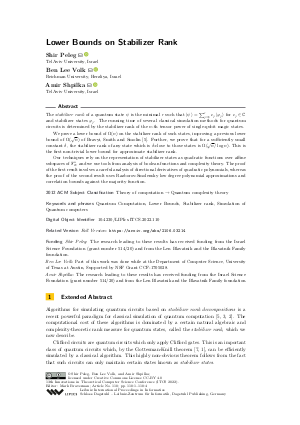Lower Bounds on Stabilizer Rank
Authors
Shir Peleg  ,
Ben Lee Volk
,
Ben Lee Volk  ,
Amir Shpilka
,
Amir Shpilka 
-
Part of:
Volume:
13th Innovations in Theoretical Computer Science Conference (ITCS 2022)
Part of: Series: Leibniz International Proceedings in Informatics (LIPIcs)
Part of: Conference: Innovations in Theoretical Computer Science Conference (ITCS) - License:
 Creative Commons Attribution 4.0 International license
Creative Commons Attribution 4.0 International license
- Publication Date: 2022-01-25
File

PDF
LIPIcs.ITCS.2022.110.pdf
- Filesize: 0.53 MB
- 4 pages
Document Identifiers
Related Versions
- Full Version https://arxiv.org/abs/2106.03214
Subject Classification
ACM Subject Classification
- Theory of computation → Quantum complexity theory
Keywords
- Quantum Computation
- Lower Bounds
- Stabilizer rank
- Simulation of Quantum computers
Metrics
- Access Statistics
-
Total Accesses (updated on a weekly basis)
0Document
0Metadata
Abstract
The stabilizer rank of a quantum state ψ is the minimal r such that |ψ⟩ = ∑_{j = 1}^r c_j |φ_j⟩ for c_j ∈ ℂ and stabilizer states φ_j. The running time of several classical simulation methods for quantum circuits is determined by the stabilizer rank of the n-th tensor power of single-qubit magic states.
We prove a lower bound of Ω(n) on the stabilizer rank of such states, improving a previous lower bound of Ω(√n) of Bravyi, Smith and Smolin [Bravyi et al., 2016]. Further, we prove that for a sufficiently small constant δ, the stabilizer rank of any state which is δ-close to those states is Ω(√n/log n). This is the first non-trivial lower bound for approximate stabilizer rank.
Our techniques rely on the representation of stabilizer states as quadratic functions over affine subspaces of 𝔽₂ⁿ, and we use tools from analysis of boolean functions and complexity theory. The proof of the first result involves a careful analysis of directional derivatives of quadratic polynomials, whereas the proof of the second result uses Razborov-Smolensky low degree polynomial approximations and correlation bounds against the majority function.
Cite As Get BibTex
Shir Peleg, Ben Lee Volk, and Amir Shpilka. Lower Bounds on Stabilizer Rank. In 13th Innovations in Theoretical Computer Science Conference (ITCS 2022). Leibniz International Proceedings in Informatics (LIPIcs), Volume 215, pp. 110:1-110:4, Schloss Dagstuhl – Leibniz-Zentrum für Informatik (2022)
https://doi.org/10.4230/LIPIcs.ITCS.2022.110
BibTex
@InProceedings{peleg_et_al:LIPIcs.ITCS.2022.110,
author = {Peleg, Shir and Volk, Ben Lee and Shpilka, Amir},
title = {{Lower Bounds on Stabilizer Rank}},
booktitle = {13th Innovations in Theoretical Computer Science Conference (ITCS 2022)},
pages = {110:1--110:4},
series = {Leibniz International Proceedings in Informatics (LIPIcs)},
ISBN = {978-3-95977-217-4},
ISSN = {1868-8969},
year = {2022},
volume = {215},
editor = {Braverman, Mark},
publisher = {Schloss Dagstuhl -- Leibniz-Zentrum f{\"u}r Informatik},
address = {Dagstuhl, Germany},
URL = {https://drops.dagstuhl.de/entities/document/10.4230/LIPIcs.ITCS.2022.110},
URN = {urn:nbn:de:0030-drops-157063},
doi = {10.4230/LIPIcs.ITCS.2022.110},
annote = {Keywords: Quantum Computation, Lower Bounds, Stabilizer rank, Simulation of Quantum computers}
}
Author Details
Funding
- Peleg, Shir: The research leading to these results has received funding from the Israel Science Foundation (grant number 514/20) and from the Len Blavatnik and the Blavatnik Family foundation.
- Volk, Ben Lee: Part of this work was done while at the Department of Computer Science, University of Texas at Austin, Supported by NSF Grant CCF-1705028.
- Shpilka, Amir: The research leading to these results has received funding from the Israel Science Foundation (grant number 514/20) and from the Len Blavatnik and the Blavatnik Family foundation.
References
- Scott Aaronson and Daniel Gottesman. Improved simulation of stabilizer circuits. Phys. Rev. A, 70:052328, November 2004. URL: https://doi.org/10.1103/PhysRevA.70.052328.
- Sergey Bravyi, Dan Browne, Padraic Calpin, Earl Campbell, David Gosset, and Mark Howard. Simulation of quantum circuits by low-rank stabilizer decompositions. Quantum, 3:181, September 2019. URL: https://doi.org/10.22331/q-2019-09-02-181.
- Sergey Bravyi and David Gosset. Improved classical simulation of quantum circuits dominated by clifford gates. Phys. Rev. Lett., 116:250501, June 2016. URL: https://doi.org/10.1103/PhysRevLett.116.250501.
- Sergey Bravyi and Alexei Kitaev. Universal quantum computation with ideal clifford gates and noisy ancillas. Phys. Rev. A, 71:022316, February 2005. URL: https://doi.org/10.1103/PhysRevA.71.022316.
- Sergey Bravyi, Graeme Smith, and John A. Smolin. Trading classical and quantum computational resources. Phys. Rev. X, 6:021043, June 2016. URL: https://doi.org/10.1103/PhysRevX.6.021043.
- Jeroen Dehaene and Bart De Moor. Clifford group, stabilizer states, and linear and quadratic operations over gf(2). Phys. Rev. A, 68:042318, October 2003. URL: https://doi.org/10.1103/PhysRevA.68.042318.
- Daniel Gottesman. Stabilizer codes and quantum error correction. Dissertation (Ph.D.), California Institute of Technology, 1997. URL: https://doi.org/10.7907/rzr7-dt72.
- Cupjin Huang, Michael Newman, and Mario Szegedy. Explicit lower bounds on strong quantum simulation. IEEE Trans. Inf. Theory, 66(9):5585-5600, 2020. URL: https://doi.org/10.1109/TIT.2020.3004427.
- Daniel J. Kleitman. On a combinatorial conjecture of erdös. Journal of Combinatorial Theory, 1(2):209-214, 1966. URL: https://doi.org/10.1016/S0021-9800(66)80027-3.
- Lucas Kocia. Improved strong simulation of universal quantum circuits. arXiv preprint arXiv:2012.11739, 2020. URL: https://arxiv.org/abs/2012.11739.
- Tomoyuki Morimae and Suguru Tamaki. Fine-grained quantum computational supremacy. Quant. Inf. Comput., 19:1089, 2019. URL: https://doi.org/10.26421/QIC19.13-14-2.
- Hammam Qassim, Hakop Pashayan, and David Gosset. Improved upper bounds on the stabilizer rank of magic states. arXiv preprint arXiv:2106.07740, 2021. URL: https://arxiv.org/abs/2106.07740.
- Alexander A. Razborov. Lower bounds on the size of bounded depth circuits over a complete basis with logical addition. Mat. Zametki, 41:598-607, 1987. English translation in Mathematical Notes of the Academy of Sci. of the USSR, 41(4):333-338, 1987. URL: https://doi.org/10.1007/BF01137685.
- Roman Smolensky. Algebraic methods in the theory of lower bounds for boolean circuit complexity. In Proceedings of the 19th Annual ACM Symposium on Theory of Computing, pages 77-82. ACM, 1987. URL: https://doi.org/10.1145/28395.28404.
- Roman Smolensky. On representations by low-degree polynomials. In 34th Annual Symposium on Foundations of Computer Science, pages 130-138. IEEE Computer Society, 1993. URL: https://doi.org/10.1109/SFCS.1993.366874.
- Maarten Van den Nest. Classical simulation of quantum computation, the gottesman-knill theorem, and slightly beyond. Quant. Inf. Comput., 10:258, 2010. URL: https://doi.org/10.26421/QIC10.3-4-6.
